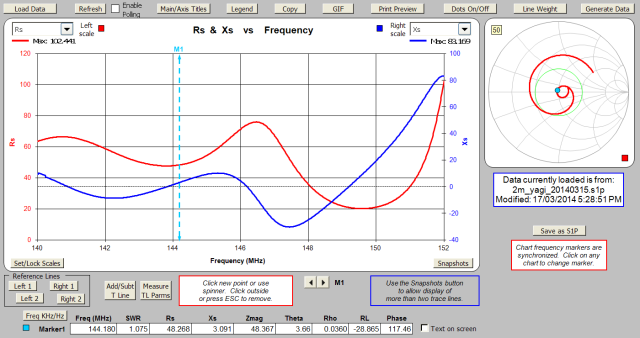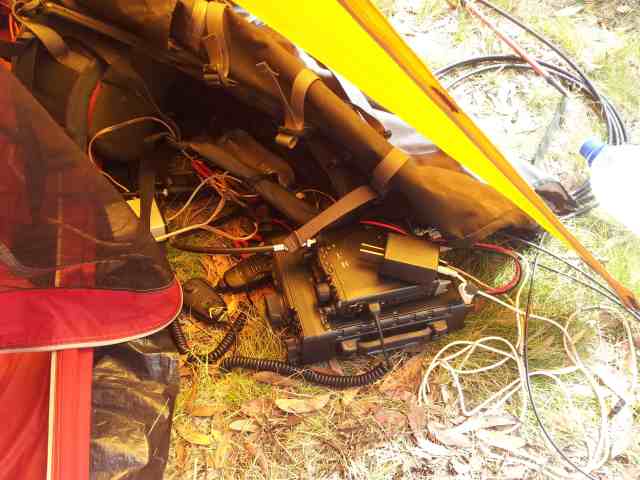Hi all,
Most of my activations are lightweight, and even more so these days, using a KX1 with a random wire antenna. Once a year, I go in an entirely different direction, and that is for the John Moyle Field day contest. This is a contest with both HF and VHF and up sections. It also rewards making seperate contacts on phone, CW and digital. It has a 6 hour section that can be timed for three rounds of contacts for each station, and they can be contacted per band.
It’s the VHF and up section that interests me. Currently that interest is on three bands 6m, 2m and 70cm.
A few years ago, I identified Mt Torbreck VK3/VN-001 as a suitable site to operate for the contest, and I went there in 2012, and again in 2013. This year, I sought to improve on previous year scored. I had dispensed with the Quadruple Quads that I had used on previous expeditions and built a 6 element yagi for 2m.
Access to the summit was the usual Barnewell Plains Rd up from Eildon Jamieson Rd. It’s a little rough, but there is no real trouble getting the Prius up here. As per last year, I would need two trips up to carry the gear.
Gear included:
- FT-897
- FT-817
- Laptop and power adaptor that could take 12V in
- Signalink USB for digital modes
- A HT for 2/70 FM
- 8 3S 5000mAh LIPOs
- 3 3S 2200mAh LIPOs
- A 12 V regulator
- Various coax pieces both LMR195 and LMR400
- Two 7m squid poles plus the lightweight 4.7m squid pole
- Two 1.5m al pole sections
- Turnstyle antenna for 6m
- Coax based colinears for 2 and 70
- A PVC based and squid pole mounted 6 element yagi for 2m
With the removal of the Quadruple Quads, it was less gear than last year. I had also taken up less battery capacity because I used little more than 50% of it last year.
As everything was carried in by hand and was battery powered, all my contacts here were SOTA contacts.
Conditions were nice during the setup. I finished the second trip up at about 11am and proceeded to setup all the gear.
Here’s the 2m colinear:
The 70cm colinear was built the previous day before the contest, and was then tested with the MiniVNAPro and Extender. It is a little hard to get the element spacing just right – I built it a little longer than a version from last year, but it still ended up a little out of band. SWRs of mid 3s to 4 are really too high, so I’ll need to make a match for it.
The gain is still very nice, and I get away with these high SWRs because the FT-897 does not develop as much power on 70. It also cuts back the power in presence of higher SWRs. Still, I need to get the SWR below 2 to give my radio an easier time and so a match will be needed – otherwise I would have to build the thing again, even longer per segment – I’m a little over building these things now!
Physically, the lightweight 4.7m squid pole was able to take the weight of the colinear, however, given that I was also attaching some LMR400 coax, I needed to support the weight of that against a tree, otherwise the pole would start to bend so that the bottom of the colinear was not far from the ground.
Next up, the 2m yagi:
In light winds, the setup for this was fine. I am going to need to guy it for stronger winds. I can guy it just below where the yagi is mounted. The mounting is a PVC pipe t piece on the pole, with the stem of the T allowing me to put on another T piece for the beam. I am going to modify the physical construction a little more along the lines of what Peter VK3PF has done, putting the elements through the beam, rather than using a wingnut to tie them onto the top of it. This will make setup and tear down simpler.
I was pretty happy with the measured results of this antenna:
This gives an SWR below 1.1 at 144.18MHz. The front to back was predicted by NEC2 to be over 30dB, and it was clearly high as I moved the yagi around. Predicted free space gain was about 16dBi. I was able to use it to work VK1DA/P during the contest, although by then, winds were very high and I had trouble keeping the thing up. So improvements for next year is a guying mount and physical improvements to the element mounting. I will also put in a BNC socket just after the common mode choke. The common mode choke on this antenna is simply 6 turns of the coax around the PVC beam right next to the feed point.
Last antenna up, the 6m turnstyle from last year. It’s not the most high gain antenna out there, but it does enough to put me in the game on 6m. I’m still thinking about whether I might put in a 2 element yagi to replace it next year, however the advantage of this thing is that I don’t need to do anything to adjust it during the contest. This is handy when in the tent because it’s raining outside.
You may notice the dark cloud in the above photo. Unfortunately, it was a sign of things to come.
So what’s missing. I have nothing horizontal polorisation for 70cm, and my plan for that is to build a 70cm yagi for next year. I’ll take the lessons learnt from building the 2m yagi this year. I am not going to bother with any vertical polorisation antenna for 6m.
The radios were setup in the vestibule of the tent:
A look at the batteries – these were 3 parallel by 2 in series (effectively the cells are 6S3P) which then feeds a 12V regulator.
It does take a little bit of work to get the workspace clean enough in the small tent. The computer was here to provide VKCL logging during the contest and to run the PSK software (Fldigi). An alternative is to run something like DroidPSK on my phone or tablet through one of my radio interfaces.

I operated for about 4 hours in the contest. There were fewer portable stations out compared to last year, and a notable absence of picking up people participating in and around Melbourne using 2/70 FM HTs. I picked up a lot of contacts last year that way.
A number of strong showers passed through, but I heard from other contest stations further southwest that conditions were getting wild. There was sounds of distant thunder, and the radar looked bad out 100km to the west, so I pulled the plug. It felt a shame to end 2 hours early – I missed a whole available contest window. Conditions were looking not so good and there was lightning around, so I did not want to risk it.
I quickly pulled down the antennas and took the high priority gear (radios, computer, etc) down to the car first. On the way back up, a decent electrical storm came through with lightning every 3 or 4 seconds. Some strikes were within 500m. That storm passed when I got back up to the top, but now it was time to take down some of the metal gear. I actually thought about abandoning it, but banked on getting off the ridge before the next storm arrived. As it turned out, I was not quite off the ridge when the next squall came through. It was lightning every 2 or 3 seconds, the rain was driving hard and the track was a river under 30cm of flowing water. There was water absolutely everywhere. I was glad that I had taken down the electronic gear on the first trip and it was in the dry car! I still was not too happy about carrying 1.5m metal poles in the middle of an electrical storm. I felt much safer once off the ridge and about 20 minutes later the storm had passed. The rain then backed off to a more usual level. I was pretty wet for the drive home!
This was quite an experience, and hopefully the summit will be more forgiving next time and allow me to get a 6 hour activation in. I got 846 points, which I felt was not bad given the 4 hours operation, plus the lower number of portable stations. I look forward to next year with 2 yagis and a matched 70cm colinear to help extend the scores above my 2013 high.
Regards, Wayne VK3WAM











You must be logged in to post a comment.